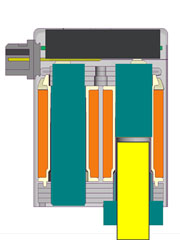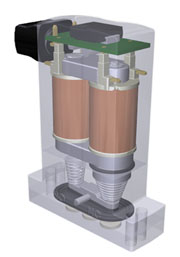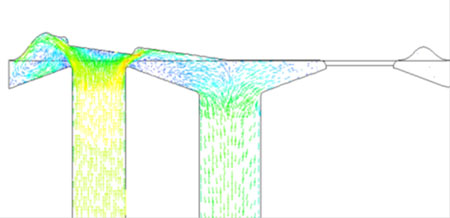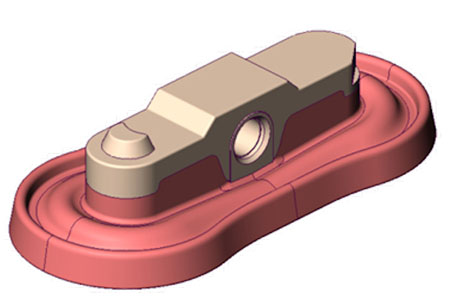In addition to piloting larger valves and controlling pneumatic automation systems, where they proliferate, small solenoid valves also perform a huge number of tasks hidden in devices that dispense, analyse, or process fluids in small quantities; anything from a lab sample analyser to a vending machine.
The traditional design comprised of a single actuation armature driven by a wound coil has not changed in principle since its invention 200 years ago by Andre-Marie Ampere. The TwinPower valve from recognised industry experts Bürkert is different: it uses rocker technology rather than the more familiar plunger type actuation and has two compact coils that operate the valve with a minimal holding current, effective after just 100ms, resulting in a 75% reduction in energy usage.

Twinpower cutaway
An impressive figure, but when we are talking about very small valves, just 10 x 20 x 44mm (WxDxH) envelope in the case of the 6624, the smaller of the two units currently available, what impact does this have on the usual reasons for reducing energy usage – reduced energy bills? The usual answer that ‘there are thousands of them in use and the cumulative effect is great’ is true, but it is more to do with the miniaturisation of medical lab equipment and energy usage at a local level.
Many industries have begun adopting green principles in the construction, operation, and maintenance of their facilities, with lab managers and healthcare facilities recently embracing this movement. One of the key factors in a successful green initiative is to evaluate power consumption and show improvements – or at least to take it into account when making decisions – and instruments consume a large portion of the power used in labs and clinics.

Twinpower cross-section drawing
Increased power usage has often been accepted as a necessary trade-off when moving from manual sample preparation and processing to automated systems, for example. By reducing power consumption by up to 75%, a microfluidic valve like the 6624, which employs a patented ‘hit and hold’ feature in the electronics, can mitigate this trade-off.
Lower power consumption is also a huge benefit to facilities in emerging markets, where the power supply may be limited or unreliable. One of the continual problems of delivering medical aid to countries such as Africa is that complex, typically western or oriental equipment requires support facilities and is not generally very mobile. This is changing as more compact and robust analysers are being designed with field use in mind.
An additional driver is the pressure on space within labs in hospitals in the developed world. The demand for instant or at least fast results is leading to on-site labs processing more critical items and lab space is under pressure, so a smaller analyser is likely to find favour with buyers and a reduced energy consumption is the icing on the cake.

Twinpower flow drawing
One notable example is a blood analyser that has been designed to use the Twin Power valve. The higher power density resulting from the combination of two coils in the actuation systems enables the valves to be much more compact in comparison with conventional actuator solutions – crucially, without any loss of performance. The power of a valve with dimensions of 16 x 26 x 46mm can now be packed into 10 x 20 x 44mm envelope. This corresponds to a reduction in design space of 54%.

Twinpower Flipperseal profile
The resulting power reduction not only has a positive effect on energy efficiency; at the same time it also reduces heat emission from the valve, resulting in a reduction in heat transfer into the medium, which is crucial to live blood samples. In addition, the surface-to-volume ratio of the valves is optimised to enable the valve coils to release heat into the surrounding atmosphere far more quickly than could previously be achieved; consequently the amount of heat transferred into the medium is reduced even further.
In summary, the new Bürkert TwinPower valves reduce space, reduce energy consumption and ultimately reduce cost: a healthy recipe in any application.

